Bluebells (scientific name: Hyacinthoides non-scripta) are a popular perennial flower around the world, known for their tendency to spread throughout a field or garden and reward growers with their delicate blooms, as per Den Garden. You’ll find that this plant doesn’t get too big, growing outward rather than upward. However, you can expect bluebells to hit heights of between 12 and 18 inches, according to Gardenia.
The common name of this plant reflects the bell-like shape of the flowers that droop from their stems in clusters. While most people think of bluebells as bluish purple in color, the blooms can also be found in white, pink, and purple, depending on the variety. Each color also boasts its own unique symbolism, according to Growing Vale. The classic blue varieties symbolize thankfulness and grief while white varieties are often seen as representing humility. Pink is an upbeat color that brings with it a feeling of joy and purple is seen as signifying forgiveness. In addition to the symbolism found in each color of this flower, the bluebell blossom itself symbolizes love, good luck, and power, which varies depending on the culture and time period.
If you’re interested in filling your garden with this enchanting flower, you’ve made a great choice. Bluebells are easy to grow when provided with their preferred growing conditions. They also don’t require too much care once planted. Check out the follow guide for everything you need to know about growing and caring for bluebell flowers.
How to use bluebells in garden
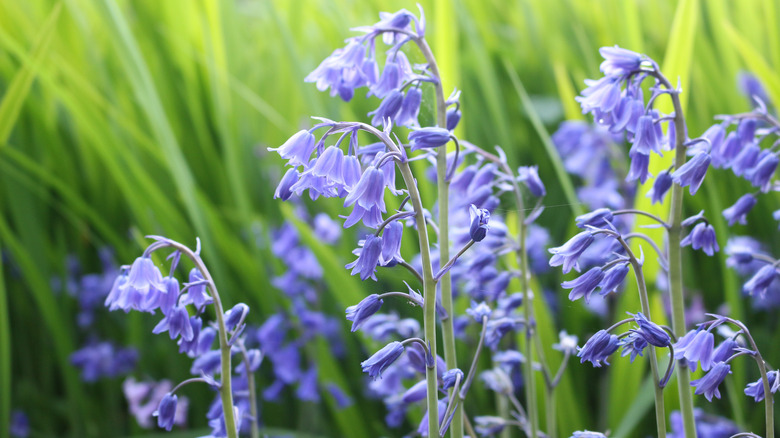
Bluebells bring the woodlands to your own backyard. They are known for their tendency to spread like wildfire during the growing season, meaning you’ll likely want to plant them in an area of your garden where they’ll have a bit of breathing room. If you find that they start to impede the growth of neighboring plants, you can always cut them back and confine them to their own bed or gated-in area. They are a great candidate for shadier areas of your garden, especially if sunny spots are in high demand, according to Better Homes & Gardens. You can even plant them underneath trees or larger shrubs to provide a colorful focal point amid an abundance of green foliage.
Once the growing season is over, bluebells go dormant, including their leaves. Easy Shade Gardening suggests giving them some evergreen companions to ensure that there aren’t any gaps in your garden once they stop blooming. A couple of popular options are ferns and hostas. You may want to consider not mixing bluebells with other flowering plants to avoid interfering with the bluebells’ carpet-like nature. However, if you do want to layer some additional colors around your bluebells, wild geraniums are a popular choice, as per Illinois Extension. Geraniums blossom later in the growing season, giving you more time to enjoy your garden in bloom. Alternatively, you can grow bluebells in pots to keep them contained to a specific area of your outdoor space.
How to grow bluebells
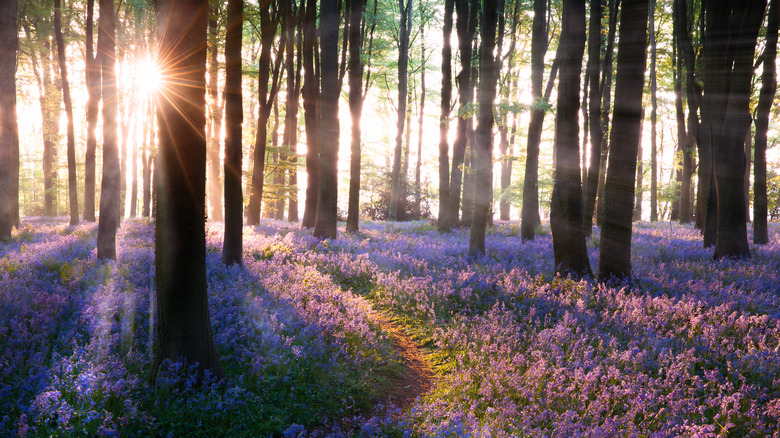
Bluebells are typically grown from bulbs or seeds, according to Gardener’s Path. The benefit to starting from bulbs as opposed to seeds is that there are less steps involved and the plant begins growing faster. You can purchase bluebell bulbs from your local nursery or divide them yourself from already-existing plants. To carry out the latter, you will need to dig up a bulb with an offshoot attached from a mature bluebell plant once the growing season has ended in the summer. The next steps are the same for both purchased bulbs and bulbs you’ve divided yourself. Using a small shovel or trowel, get to work digging holes at a maximum of 4 inches deep and 6 inches apart. The soil should be loose when you place the bulb in the hole. Make sure the offshoot is facing upwards before filling in the hole with soil. You can add some compost into each hole for added nutrition and then water generously once the bulbs are situated.
If you choose to plant your bluebells from seed, you should do so in the late summer. You can either sprinkle them directly in your garden or allow them to germinate first in small growing pots. In both cases, you will need to ensure the soil is loamy and full of organic matter. If it isn’t, you can always mix in some compost or manure. Note that in both cases, your bluebells can take up to two years to germinate.
How to care for bluebells
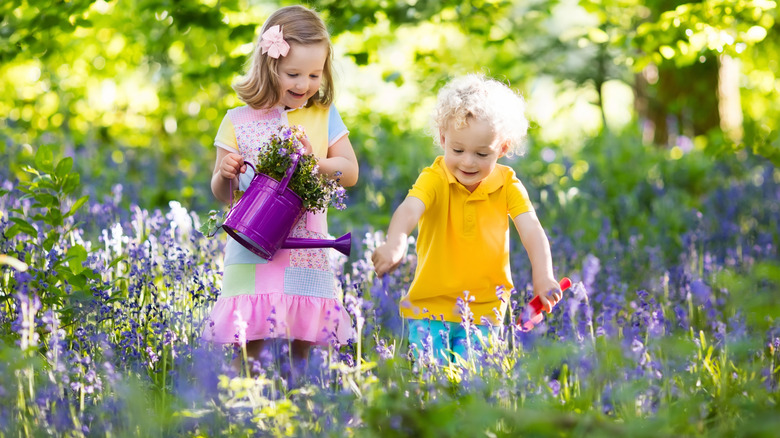
FamVeld/Shutterstock
Bluebells grow best in USDA hardiness zones 4 through 9, as noted by The Spruce. If you live in these regions, caring for bluebells will require little effort on your part. You will need to pay attention to the amount of sun your bluebells receive throughout the late-spring/early-summer growing season. While they will grow in direct or indirect sunlight, they do have a preference for shady locations where they aren’t being bombarded with sunlight the entire day. Bluebells also aren’t overly fussy when it comes to soil composition once they are well-established. You will need to provide them with fertilizer that is rich in potassium about twice a month from the moment they bloom in early spring until they go dormant in mid-summer.
You may be happy to learn that bluebells won’t increase your water bill by very much; they only require sparse watering throughout the growing season. Note that they should never sit in soggy soil to avoid fungal infections and rot. As a general rule of thumb, it is best to keep them on the dryer side. If you live in a location that receives rainfall during the summer, you may find that your bluebells won’t need any additional water. As your bluebells grow, it will be important to weed regularly to ensure they reach their full potential. You can also prune the plant by removing dead blooms and cutting back on stems and foliage at the end of the season.
Varieties of bluebell
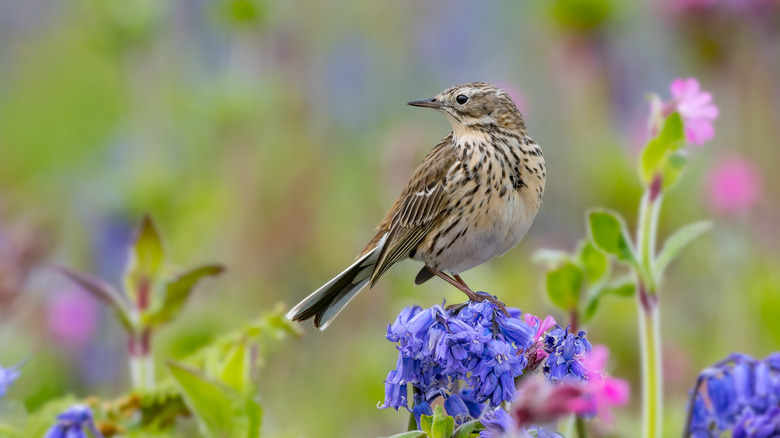
bearacreative/Shutterstock
The common bluebell, which goes by the scientific name Hyacinthoides non-scripta, is native to the western regions of Europe, according to Petal Republic. Swedish botanist Carl Linnaeus was the first to identify this flowering plant in 1753 and went on to classify it as part of the Hyacinthoides genus, which includes the popular, and slightly similar, hyacinth flower. The plant has since made its way across Europe and to other regions of the world, including North America, where it can often be found growing in the wild. Nowadays, there are a variety of bluebells in existence, with many resulting from the hybridization of the plant with other species.
The English bluebell is the original variety still in existence today, as per Home Stratosphere. This variety features the blue-purple blooms commonly associated with bluebells and is often found carpeting woodland areas in the wild. The Spanish bluebell differs from the English variety in that it prefers growing in open areas as opposed to within forests. It is also larger, reaching heights of up to 3 feet. Spanish bluebells come in more than one color, featuring blooms in pink and white as well as the traditional blue. Hybrid bluebells cross the English with the Spanish varieties but have more of the Spanish characteristics. The Scottish bluebell, which also goes by the name harebell, has a light-blue blossom while the Virginia bluebell is similar in color but is found in North America and hits 2 feet in height.
Are bluebells toxic?
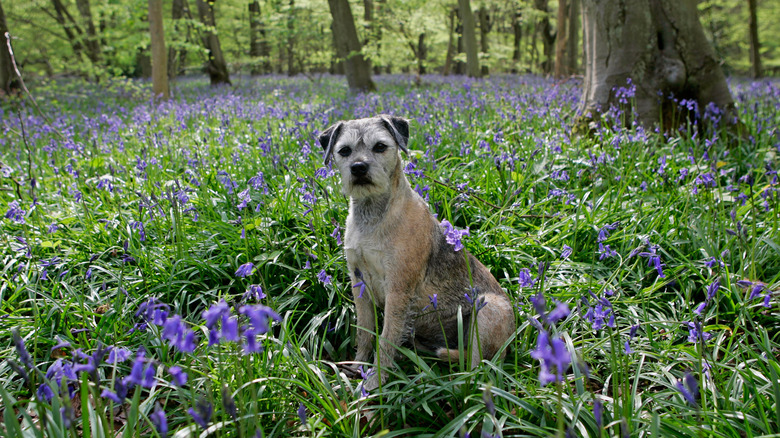
Tim Graham/Getty Images
Unfortunately, bluebells are considered a toxic plant to all animals, humans included, as they contain a substance known as glycosides that are poisonous when ingested, as per Woodland Trust. If any part of the plant is accidentally ingested, symptoms are typically limited to the digestive system and can include general stomach upset, vomiting, and diarrhea. In large quantities, bluebells can also be fatal. Bluebell bulbs are often mistaken for onions, which can lead to consumption to the untrained eye. If you or someone in your family ingests the bluebell plant or its bulb, contact your nearest poison control center or emergency hospital for immediate treatment. The same goes for any plant-loving pets that may have decided to snack on some bluebells.
If you have pets or young children and would still like to plant bluebells in your garden, there are precautions you can take to ensure everyone stays safe. The most common way to prevent children and pets from having access to your bluebells is to use physical barriers, such as a wall or fence. If this isn’t possible due to the spreading nature of the plant, you can also use a bitter spray to dissuade anyone from putting it in their mouth. Pets can also be trained to stay away from the areas in your yard where bluebells grow using rewards and positive reinforcement techniques. Ultimately, it is always best to supervise children and plant-curious pets whenever possible.
How to repot bluebells
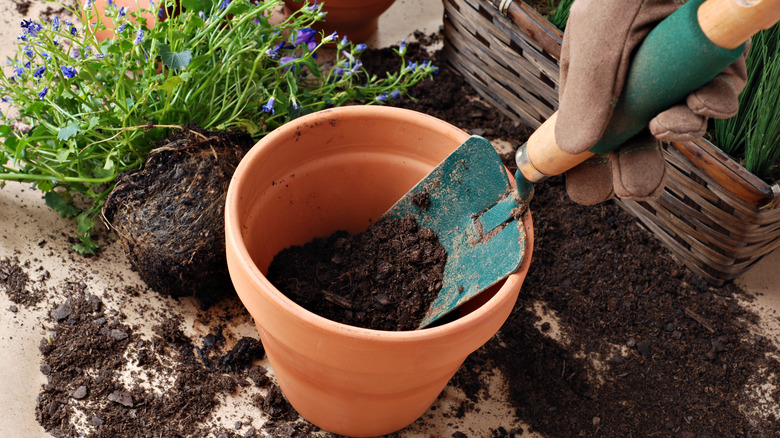
Marie C Fields/Shutterstock
If you’ve decided to plant your bluebells in pots or containers, there will likely come a point when you will need to upgrade the container to a bigger size. Planta points out a few signs that your bluebells have outgrown their current pot. You may notice that roots are emerging through the drainage holes at the base of the pot or that the soil has stopped absorbing moisture and water drains directly out of the pot. In the latter case, there are too many roots for the quantity of soil, which prevents the soil from being able to hold onto moisture. Another common sign is that the plant starts to die without any other apparent reason.
Once you’ve identified that your bluebell needs more room, you should purchase a new pot with several drainage holes that is one size larger. You will also need well-draining potting soil. The first step is to sprinkle a layer of soil in the new pot to cover the base. You will then need to carefully remove your bluebell from its previous pot and shake off the old soil. Place it in the new container and fill in the rest of the space with fresh soil. You should then give it a healthy drink of water and place it somewhere with some extra sun while it gets used to its new home. Note that you don’t need to supply any fertilizer as the new soil will provide enough to start with.
Bluebell pests and diseases
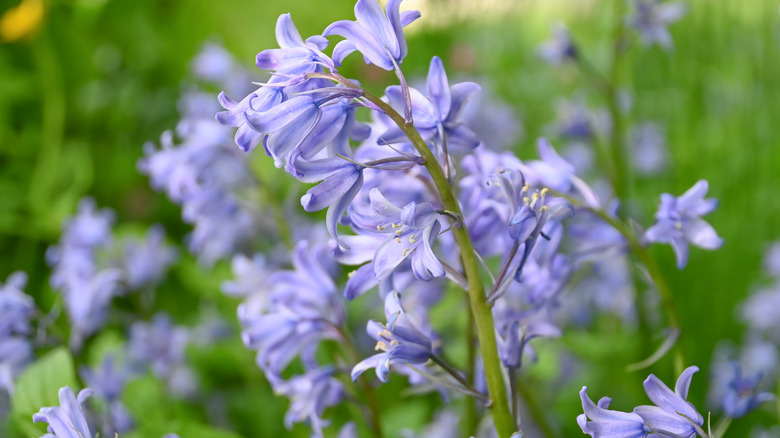
Lynne Nicholson/Shutterstock
Bluebells are the target of a few different pests and diseases that can threaten their health, and in extreme cases, their life, as per SFGate. You may notice any of the following insects munching on the various parts of your bluebells: aphids, thirps, mealy bugs, and leafminers. There are several different methods that you can choose from to get rid of these pests, depending on the severity of the infestation and the availability of the materials. Birds & Blooms suggests removing any sick or weak plants as the first step in freeing your bluebells of insect infestations. You can then use insect traps or introduce natural predators to kill the existing pests. In extreme cases, you may need to resort to using a chemical insecticide.
SFGate also outlines a number of common diseases that can infect your bluebells. Root rot is one of the most common, which is caused when the plant is overwatered and forced to sit in perpetually moist soil. The fungus attacks the roots first before making its way up the rest of the plant. Leaf spot and blight both affect the leaves, often destroying and killing them. For fungal diseases, consider spraying a fungicide to treat your bluebells. Any infected individuals should be disposed of to prevent the continued spread to healthy plants. You can keep fungal diseases at bay by avoiding overwatering and pruning regularly to allow for adequate air circulation.



